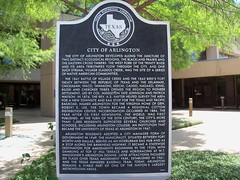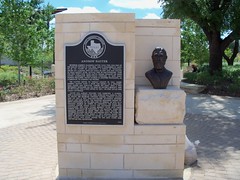Andrew Shannon Hayter
Andrew Shannon Hayter
man
Aged unknown
Commemorated on 3 plaques
Texas Historical Marker #05760
West Fork United Presbyterian Church. In 1870 the Rev. Andrew Shannon Hayter organized the Good Hope Cumberland Sabbath School to serve the early settlers of the surrounding area. The first church building, which was also used as a schoolhouse, was located in the vicinity of the Watson Cemetery (2 mi. SW) on property donated by P.A. Watson. In 1872 the congregation adopted the name West Fork. The Church's third sanctuary, built two years after a destructive 1924 fire, was moved to this location in 1955 during construction of the Dallas-Fort Worth Turnpike. #5760
602 Santerre Rd., Grand Prairie, TX, United States where they founded
Texas Historical Marker #13792
City of Arlington. The city of Arlington developed along the juncture of two distinct ecological regions, the Blackland Prairie and the Eastern Cross Timbers. The West Fork of the Trinity River and its area tributaries flow through the city, and one such stream, Village (Caddo) Creek, was the site of a series of Native American communities. The 1841 Battle of Village Creek and the 1843 Bird's Fort Treaty between the Republic of Texas and the Delaware, Chickasaw, Waco, Tawakoni, Keechi, Caddo, Nadako, Ionie, Biloxi and Cherokee tribes opened the region to pioneer settlement, led by Col. Middleton Tate Johnson and Patrick Watson. In 1876, the Rev. A. S. Hayter helped survey the area for a new townsite and rail stop for the Texas and Pacific Railroad. Named Arlington for the Virginia home of Gen. Robert E. Lee, the town became a regional cotton distribution center. Incorporation occurred in 1884, the year after its first newspaper, The World, was first published. At the turn of the 20th century, the city's more than 1,000 residents supported several churches and schools, including Arlington College, an institution that became the University of Texas at Arlington in 1967. Arlington residents adopted a city manager form of government in 1949. The municipality, situated between Fort Worth and Dallas, served as an interurban rail hub and as a stop along the Bankhead Highway. It became a statewide destination for amusements beginning in the 1920s with gambling at Top O'Hill Terrace and horseracing at W.T. Waggoner's Arlington Downs. Later attractions included Six Flags Over Texas amusement park, established in 1961, and the Texas Rangers baseball team. Today, Arlington remains a viable part of one of the nation's largest metropolitan areas. (2006) #13792
101 W. Abram St., Arlington, TX, United States where they surveyed
Texas Historical Marker #15722
Andrew Hayter. Reverend Andrew Shannon Hayter (1818-1900) was one of the earliest settlers in this area, and is considered by many to be the "Father of Arlington." A native of Tennessee, Hayter left Alabama with his family in late 1850 and arrived in Texas shortly after, settling first in Nacogdoches. Over the next forty-nine years Hayter would establish or serve sixteen Cumberland Presbyterian churches. As with many pioneer preachers, Hayter worked in another procession, as a surveyor, to augment his income. The Hayters moved to Tarrant County in 1869, where Andrew quickly made a name for himself as a preacher, civic leader and surveyor. During the early 1870s a tiny settlement developed on the edge of Hayter's property, and he petitioned for a post office in 1875. The post office was called Haytersville. Hayter had already founded two churches, a school, and a Masonic Lodge in the area when he was asked in 1876 to locate the railroad through eastern Tarrant County and lay out a tiny, half-mile-square settlement between Dallas and Fort Worth. The railroad designers needed in-depth knowledge of the area and its terrain, as well as a plentiful source of timber to construct the road bed. Andrew Hayter could supply the necessary surveying knowledge, and also owned property filled with large timbers that could be furnished to the railroad. When the railroad offered to name their new town Hayter, the reverend declined the offer and instead gave the town the name Arlington, after Robert E. Lee's Virginia estate. The birth of Arlington caused the demise of tiny Hayterville. The post office was soon moved to the new town and Hayterville was abandoned. (2009) #15722
North east corner of W. Abram St. and S. Center St., Arlington, TX, United States where they was



